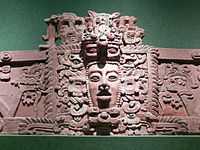Jolja'
 |
| Maya civilization |
|---|
| History |
| Preclassic Maya |
| Classic Maya collapse |
| Spanish conquest of the Maya |
Jolja' is an archaeological site of the pre-Columbian Mayan civilization, located in the Chiapas highlands of central southern Mexico. Also known as Cueva de Jolja' (or Jolja) in Spanish, the site is a cave which contains a painted mural and a number of inscriptions in the Mayan script which date back to the Early Classic period (ca. 3rd to 7th centuries CE).
Overview
The name jolja' is from the Ch'ol language, one of the Mayan languages, meaning "at the head of the water", referring to its being the source of the headwaters of the Ixtelja River, which emerge from mouth of one of three interconnected caves to flow down a steep escarpment on the eastern side of Misopa' Mountain to the valley below. The three caves are collectively referred to as "Cueva de Jolja'" by the local Ch'ol Mayan inhabitants. The highest and drier of these containing the inscriptions and other evidence of use in pre-Columbian times.
The Maya performed rituals in many caves and left behind many artifacts. Though there are many such caves in the area, few of them have been found to contain murals or hieroglyphic writing.
The cave is still used today by the local Ch'ol Mayan of the nearby Joloniel community for their Day of the Cross ceremonies.
The main Jolja' cave contains one mural with accompanying inscriptions as well as at least five other groups of inscriptions. It was common for Mayan elites to wear quetzal feather headresses. The Ajaw sign appears above two of the figures depicted in the mural. There are several dates that are present at Jolja' Cave. These dates are a part of the Mesoamerican Long Count calendar. The Long Count calendar is divided into units of 360 days called tuns. Major ceremonies were held at the end of every katun or 20 tuns. Dates include Ajaw 3 Sak (December 14, 297 CE), Ajaw 18 Yaxk'in (October 8, 310 CE), and Ajaw 3 Muwan (February 1, 426 CE).
The Day of the Cross ceremonies are conducted at Jolja cave on May 3. This is a Catholic festival, but there are aspects of pre-Columbian rain rituals incorporated in them, because May 3 is the start of the rainy season.
See also
- Mayan cave sites
References
- Bassie, Karen; Jorge Pérez De Lara and Marc Zender (2000). "Jolja' Cave". Mesoweb. Retrieved 2006-08-14.
Template:Mayan sites